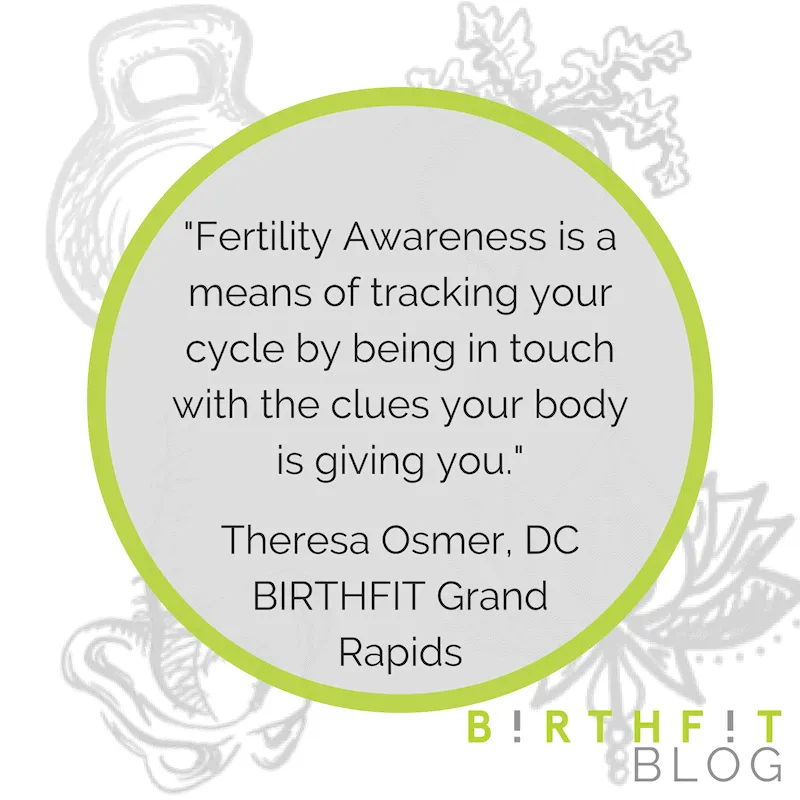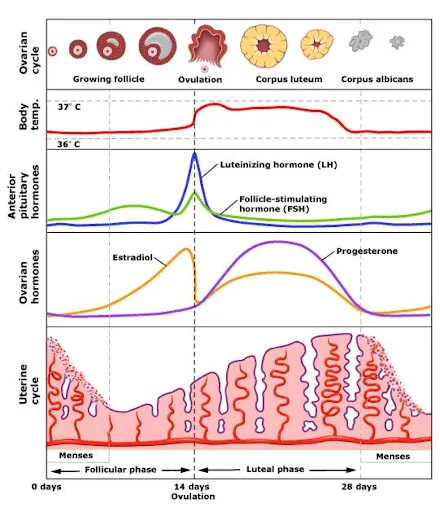How many of us have been embarrassed by our period? I know I have.
We have been programmed by society to be ashamed and “grossed out” by this visitor every month to the point of using birth control to suppress its appearance. Then, as we get older and start thinking about family planning, our mindset around our period may change from one of dread to one of attentiveness and curiosity: Can I really get pregnant any day of the month? (no, by the way). How do I know when I am ovulating? What is the first day of my cycle: is it day 1 of my period or the last day of my period? We can diminish shame and unlock so many questions through Fertility Awareness.
Fertility Awareness is a means of tracking your cycle by being in touch with the clues your body is giving you.
Paying attention and tracking your cycle can tell you how well your nutrition is going, how you’re managing your stress level, when you are and are not fertile depending on if you are trying to conceive (TTC) or trying to avoid (TTA), as well as if there is something going on that requires a trip to the gynecologist for further investigation. For example, Lara Briden, ND, calls our period our “Monthly Report Card” of health in her book, The Period Repair Manual (1). Symptoms like clotting, cramping, debilitating pain, and excessive bleeding, defined as 80mL or more lost per cycle, and abnormal length or frequency of the cycle can be signs that there is something going on in our body that needs to be addressed (3). Below, we’ll explore how the female cycle works, and how to use Fertility Awareness Method to track your health month to month!
How the female cycle works
On average, a woman’s cycle lasts 28 days. While a cycle can vary from woman to woman, a cycle that is consistently under 25 days or over 35 days or that varies widely month to month is considered abnormal and should be investigated. The first day of your cycle is the first day that you experience regular bleeding, not spotting. Spotting for a day before full flow is normal, but more than one day may indicate a problem. Ovulation will then occur around day 14 of your cycle if you have a 28 day cycle, although again this may vary from woman to woman.
There are four main hormones at play: Follicle Stimulating Hormone (FSH), Luteinizing Hormone (LH), Estrogen, and Progesterone. All of these hormones are at their lowest on day 1 of your cycle which triggers the bleed to happen. Let’s break down the job of specific hormones during the phases mentioned above.
Follicle stimulating hormone will rise throughout the follicular phase (bleeding and non-bleeding) and will have another rise at ovulation. This hormone matures the developing follicle which will become the released egg that month (2).
Estrogen is the sex hormone present during this first half of the cycle, the follicular phase. Estrogen’s job is to grow and thicken the uterine lining to prepare it for potential implantation of a fertilized egg. Estrogen also can do marvelous things for your skin, plump your lips, and make you feel your most feminine. Estrogen is also what produces the changes in cervical mucus discharge and the LH surge to happen, which will be discussed later (2). With the increase in estrogen, you may feel more outgoing and extroverted. This is a great time to schedule meetings and get things done!
At ovulation, all of the hormones except for progesterone peak to trigger the release of the egg. Luteinizing Hormone (LH) has a particularly important job at the end of the follicular phase, as it sharply peaks to allows the follicle to expel the egg for ovulation (2). This is the hormone you can test on an Ovulation Predictor Kit (OPK) to know if you are about to ovulate. Ovulation happens 12-36 hours after the LH surge. Some kits also test estrogen, which rises before LH and can give you more of a head’s up that ovulation is about to occur (4). For couples TTC, timing intercourse when you see the LH surge and then for 2 days after can help fertilize the egg when it is released. A word of caution, there are some cons to these tests, one being that they do not confirm that ovulation actually occurred. LH can surge because your body is trying to ovulate, but an egg is not released. One way to confirm egg release is to measure your basal body temperature, which I will discuss shortly. Your temperature should rise after ovulation due to the warming effects of the next hormone discussed, progesterone.
After ovulation, we are now in the Luteal Phase. Estrogen is still present after the release of the egg, but progesterone is now the more dominant hormone. Progesterone is produced by the corpus luteum which used to contain the egg. If the egg is fertilized, the corpus luteum maintains progesterone levels for the first 10-12 weeks of pregnancy until the placenta takes over. If the egg is not fertilized, the corpus luteum becomes inactive and is known as the corpus albicans (2). Checking progesterone levels can be important for women who have difficulty conceiving or for those who have suffered miscarriage. This test can also confirm whether or not you ovulated. Your doctor can order a progesterone blood test to be done mid-way through your luteal phase, around day 21 your cycle if your cycle length is the average 28 day cycle. If not, the test should be done either 7 days after you think you ovulated or 7 days before your next period is expected to start (1). Some effects that progesterone has on your body includes breast tenderness to ready the tissue to hold milk, which is why this is a common symptom before your period begins. Progesterone also gets your uterine lining ready to be shed if you do not become pregnant (2). Estrogen and Progesterone are sidekicks and need to work in balance for a woman to have a healthy reproductive system. The Luteal Phase is a good time to focus on detoxification; support your liver with B-vitamins and cruciferous veggies to help process the hormone surges that have happened. Detoxification may also include looking to your relationships or other activities that are not serving you.
Hormonal birth control obviously interferes with this intricate cycle of hormones because the pill suppresses your ovarian function. A bleed on birth control is not a true menstruation. Going down the birth control rabbit hole is a great blog for another time, so in order to keep the focus on educating about fertility awareness, I will leave you with this podcast episode from “Stuff You Should Know” about the history of birth control and this BIRTHFIT blog post.
Photo courtesy of https://www.forresthealth.com/female-hormone-cycle/
Fertility Awareness Method
Once you understand the basic tenants of the cycle, you can apply the concepts of cycle tracking. One method is Fertility Awareness Method (FAM) which tracks temperature monitoring, changes in cervical mucus, as well as cervical position, to understand exactly when you are fertile. Ashley Hartman Annis has created an easy to use and apply booklet for this method. Another wonderful book that goes into all of the details of this method is Taking Charge of Your Fertility by Toni Weschler.
Temping is taking your temperature first thing in the morning to tell you if and when you ovulated. Once an egg is released, progesterone is circulated giving you a spike in temperature after ovulation occurs. We want to see that temperature increased for at least three days to know ovulation occurred and remain elevated for at least 11 days to show you produce enough (1). This is especially important for women who have had miscarriages, possibly due to low progesterone. If temperature is not elevated for at least 11 days, this may indicate Luteal Phase Deficiency which should be further investigated with a single Progesterone blood test discussed above (1).
You can use any basal body thermometer (BBT), but my favorite is the Daysy thermometer because it is so intuitive and 99.4% accurate after three months of consistent use at predicting your fertility.
Cervical Mucus checking is another aspect of FAM. Variations in estrogen produces changes in cervical mucus. In the early part of your cycle, before ovulation, mucus is dry and changes to thick and sticky; this mucus will slow or stop the sperm so it cannot make it into your fallopian tubes for fertilization. Clear, slippery, and stretchy characterizes fertile mucus.
When a fertile window is discussed, it takes into consideration that sperm can live for a maximum of five days in the female reproductive track and that you can ovulate a second time within 24 hours of the first ovulation. So I tell my clients: your fertile window is five days before ovulation (you should know when you ovulate from past months and then also start picking up on the signs of ovulation about to occur like abdominal pain and changes in cervical mucus), the day of ovulation (your peak day), plus four days past your peak mucus. Remember, temperature increase of at least three days confirms that ovulation did occur. This gives you 10 days for a fertile window (5).
As you can see, there is a lot going on during the month that you may never have realized! If you track, you may notice how stress, nutrition, sleep, and exercise can impact your monthly cycle. Remember, information is empowering and it is normal to be overwhelmed at first when you are tracking. After a few cycles, it starts to feel much more manageable.
Photo courtesy of https://www.forresthealth.com/female-hormone-cycle/
Theresa Osmer, DC
BIRTHFIT Grand Rapids
@birthfit_grandrapids_mi
Resources:
- Briden ND, Lara (2017) Period Repair Manual 2nd Edition. Middletown, DE: CreateSpace Independent Publishing Platform.
- Weschler MPH, Toni (2015) Taking Charge of Your Fertility 20th Anniversary Edition. Seattle, WA: William Morrow Paperbacks.
- https://obgyn.onlinelibrary.wiley.com/doi/pdf/10.1576/toag.6.2.88.26983
- https://www.verywellfamily.com/all-about-ovulation-predictor-kits-1960227
- http://www.nataliecrawfordmd.com/thepodcast/episode-007-the-menstrual-cycle-period
- https://www.forresthealth.com/female-hormone-cycle/
- https://www.instagram.com/p/BuGzLjyAMKR/



